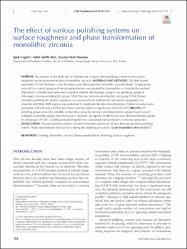| dc.contributor.author | Çağlar, İpek | |
| dc.contributor.author | Ateş, Sabit Melih | |
| dc.contributor.author | Duymuş, Zeynep Yeşil | |
| dc.date.accessioned | 2020-12-19T19:41:53Z | |
| dc.date.available | 2020-12-19T19:41:53Z | |
| dc.date.issued | 2018 | |
| dc.identifier.citation | Caglar, I., Ates, S. M., & Yesil Duymus, Z. (2018). The effect of various polishing systems on surface roughness and phase transformation of monolithic zirconia. The journal of advanced prosthodontics, 10(2), 132–137. https://doi.org/10.4047/jap.2018.10.2.132 | en_US |
| dc.identifier.issn | 2005-7806 | |
| dc.identifier.issn | 2005-7814 | |
| dc.identifier.uri | https://doi.org/10.4047/jap.2018.10.2.132 | |
| dc.identifier.uri | https://hdl.handle.net/11436/1847 | |
| dc.description | Ates, Sabit Melih/0000-0001-7137-2096; caglar, ipek/0000-0002-2286-4657 | en_US |
| dc.description | WOS: 000431063600008 | en_US |
| dc.description | PubMed: 29713434 | en_US |
| dc.description.abstract | PURPOSE. the purpose of this study was to evaluate and compare three polishing systems on the surface roughness and phase transformation of monolithic zirconia. MATERIALS AND METHODS. 100 disk shaped specimens (10 mm diameter, 3 mm thickness) were fabricated from monolithic zirconia blocks. 20 specimens were left as a control group and remaining specimens were grinded by diamond bur to simulate the occlusal adjustments. Grinded specimens were randomly divided into 4 groups: group G (no polishing), group M (Meisinger, zirconia polishing kit), group E (EVE Diacera, zirconia polishing kit), and group P (EVE Diapol, porcelain polishing kit). Surface roughness was measured with profilometer and surface topography was observed with SEM. XRD analysis was performed to investigate the phase transformation. Statistical analysis was performed with one-way ANOVA and Tukey's post hoc tests at a significance level of P=.05. RESULTS. All polishing groups showed a smoother surface than group G. Among 3 polishing systems, group M and group E exhibited a smoother surface than the group P. However, no significant differences were observed between group M and group E (P >.05). Grinding and polishing did not cause phase transformations in zirconia specimens. CONCLUSION. Zirconia polishing systems created a smoother surface on zirconia than the porcelain polishing system. Phase transformation did not occur during the polishing procedure. | en_US |
| dc.language.iso | eng | en_US |
| dc.publisher | Korean Acad Prosthodontics | en_US |
| dc.rights | info:eu-repo/semantics/openAccess | en_US |
| dc.subject | Grinding | en_US |
| dc.subject | Monolithic zirconia | en_US |
| dc.subject | Phase transformation | en_US |
| dc.subject | Polishing | en_US |
| dc.subject | Surface roughness | en_US |
| dc.title | The effect of various polishing systems on surface roughness and phase transformation of monolithic zirconia | en_US |
| dc.type | article | en_US |
| dc.contributor.department | RTEÜ, Diş Hekimliği Fakültesi, Klinik Bilimler Bölümü | en_US |
| dc.contributor.institutionauthor | Çağlar, İpek | |
| dc.contributor.institutionauthor | Ateş, Sabit Melih | |
| dc.contributor.institutionauthor | Duymuş, Zeynep Yeşil | |
| dc.identifier.doi | 10.4047/jap.2018.10.2.132 | |
| dc.identifier.volume | 10 | en_US |
| dc.identifier.issue | 2 | en_US |
| dc.identifier.startpage | 132 | en_US |
| dc.identifier.endpage | 137 | en_US |
| dc.ri.edit | oa | en_US |
| dc.relation.journal | Journal of Advanced Prosthodontics | en_US |
| dc.relation.publicationcategory | Makale - Uluslararası Hakemli Dergi - Kurum Öğretim Elemanı | en_US |


















